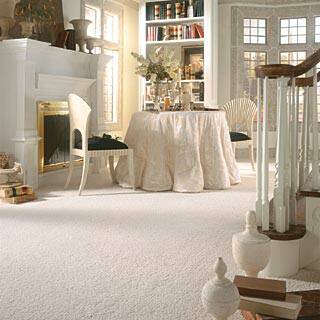Carpeting is an attached floor covering made of a heavy, thick fabric, usually woven or felted, often wool, but also cotton, hemp, straw, or a synthetic counterpart. Polypropylene, commonly called Olefin, is a very common pile yarn, as is nylon. It is typically knotted or glued to a base weave. It is made in breadths of 12 or 15 feet (2m, 3 m or 4 m outside the USA) to be cut, seamed with a seaming iron and seam tape (formerly it was sewn together) and affixed to a floor over a cushioned underlay (pad) using nails, tack strips (known in the UK as carpet rods or stair rods, when used on stairs), (gripper) or adhesives, thus distinguishing it from rugs or mats, which are loose-laid floor coverings. For environmental reasons, the use of organic wool, natural bindings, natural padding, and formaldehyde-free glues is becoming more common. These options are almost always at a premium cost, though with no sacrifice to performance. In the UK carpets are still manufactured for pubs and clubs in a narrow width of 27" (0.69m) and then sewn to size. Carpeting which covers an entire room area is loosely referred to as 'wall-to-wall', but carpet can be installed over any portion thereof with use of appropriate transition moldings where the carpet meets other types of floor coverings. Carpeting is more than just a single item; it is, in fact, a system comprising the carpet itself, the carpet backing (often made of latex), the cushion, and a method of installation. Carpet tiles are squares of carpet, typically 0.5 m square, that is melted into high-density vinyl that can be used to cover a floor. They are usually only used in commercial settings and are affixed using a special pressure-sensitive glue, which holds them into place while allowing easy removal(in an office environment, for example) or to allow rearrangement in order to spread wear.
Modern carpeting is often attached to the floor (or stairways) of a building and, when considered permanently attached, would be part of the real property which includes the building. Oriental carpets began to appear in Europe after the Crusades in the 11th century. Until the mid-18th century they were mostly used on walls and tables. Except in royal or ecclesiastical settings they were considered too precious to cover the floor. Starting in the 13th century Oriental carpets begin to appear in paintings (notably from Italy, Flanders, England, France, and the Netherlands). Carpets of Indo-Persian design were introduced to Europe via the Dutch, British, and French East India Companies of the 17th and 18th century.
Home design ideas, Home Decoration, Interior Design ideas 2011, Interior Decorating Ideas, Modern Flooring ideas, Modern Door design ideas, Modern Kitchen and Bathroom ideas and much more...!
Skylines Search
Thursday, December 2, 2010
Indoor Carpet Design Photos
Subscribe to:
Posts (Atom)




